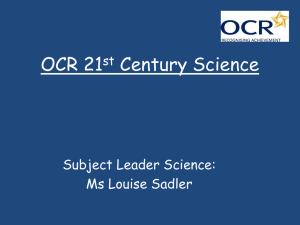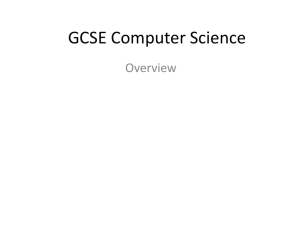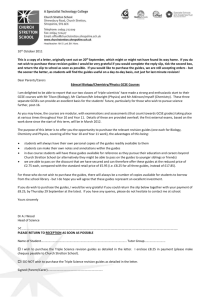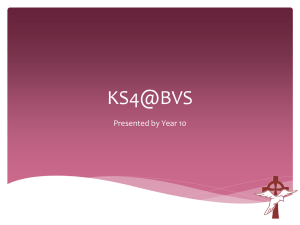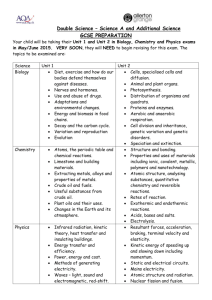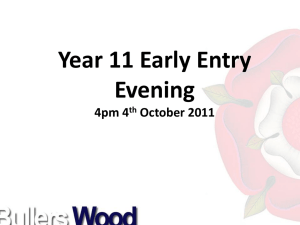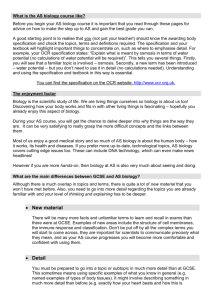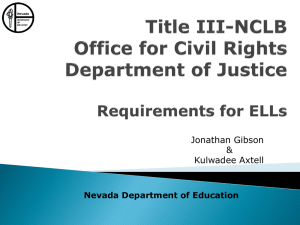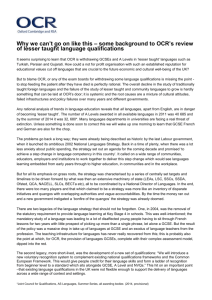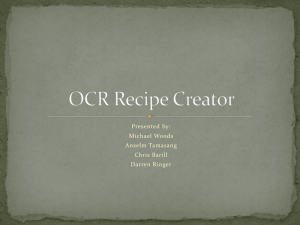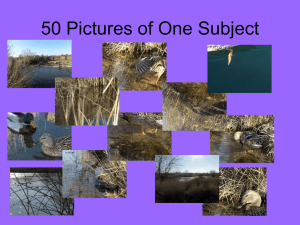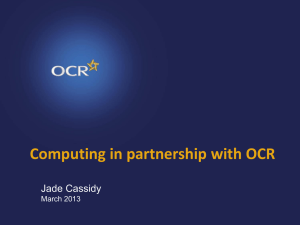y11-rev-parents-science
advertisement
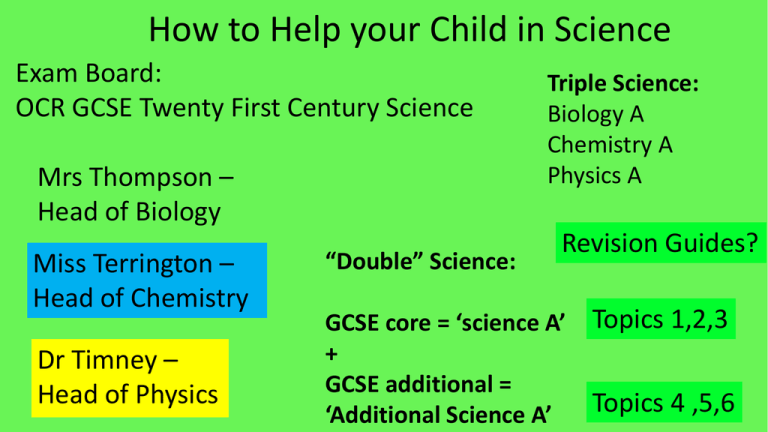
How to Help your Child in Science Exam Board: OCR GCSE Twenty First Century Science Mrs Thompson – Head of Biology Miss Terrington – Head of Chemistry Dr Timney – Head of Physics “Double” Science: Triple Science: Biology A Chemistry A Physics A Revision Guides? GCSE core = ‘science A’ + GCSE additional = ‘Additional Science A’ Topics 1,2,3 Topics 4 ,5,6 Exam Board: OCR GCSEs Twenty First Century Science Triple Science: Biology A http://www.ocr.org.uk/qualifications/gcse-twenty-first-century-science-suite-biology-a-j243-from-2012/ Chemistry A http://www.ocr.org.uk/qualifications/gcse-twenty-first-century-science-suite-chemistry-a-j244-from-2012/ Physics A http://www.ocr.org.uk/qualifications/gcse-twenty-first-century-science-suite-physics-a-j245-from-2012/ “Double Science” is these two GCSEs: Science A (‘core science’) GCSE http://www.ocr.org.uk/qualifications/gcse-twenty-first-century-science-suite-science-a-j241-from-2012/ Plus Additional Science A GCSE http://www.ocr.org.uk/qualifications/gcse-twenty-first-century-science-suite-additional-science-a-j242-from-2012/ Students doing “Core Science” are just studying this one: Science A (‘core science’) GCSE http://www.ocr.org.uk/qualifications/gcse-twenty-first-century-science-suite-science-a-j241-from-2012/ Help will be at hand at… Revision Guides? Active Revision ! Eg …. Y11 Revision Website Edmodo ‘Processing’ Mind Maps Flash cards of key words & definitions ‘Revision Bunting’ / post it notes The idea of ‘bespoke mind maps’ are that they are individual to the learner. This one is shown as an example. It uses a mixture of pictures / diagrams and colour, as well as words to trigger the memory. This particularly suits more ‘spatial learners’ / visual learners. Emphasis is added by changing the size / width of arrows. If you want to find out what type of learner you / your child is, there are various website where you can find this out eg: http://www.varklearn.com/english/page.asp?p=younger Word & ‘visual’ prompt ‘Definition’ needs to be ‘student-speak’ Add a ‘personal association’ with it – to aid memory retrieval of the definition. My Granddad’s cat kept dragging mice into the house because it is a good predator ! Design of flashcards: Cards are colour coded: Green for biology Blue for chemistry Yellow for physics Biology Chemistry This can help students to ‘file’ the information correctly & it fits in with the colour codes that we use for exercise books in class. Physics Word Visual Representation Design of flashcards – back of flashcards: Student Definition Personal Association This enables the brain to make a link’ that is attached to emotion / one’s own experiences. The link between the word and the definition is then reinforced by repeated ‘retrieval’ from the brain or by ‘rehearsal’. between the word and the definition because it has a ‘personal association This needs to be ‘active’ , not ‘passive’; so making the brain ‘do stuff’, not just staring at a book! Going through the flash cards time & time again is (akin to practising a dance move or tennis stroke). This is an example of a flash card that is not quite right, although it does have some redeeming features ! Word & ‘visual’ prompt ‘Definition’ needs to be ‘student-speak’ … not copied from the internet! Add a ‘personal association’ with it – to aid memory retrieval of meanings. For those who are interested, this is some further information about how psychologists think the ‘mind’ works. The idea with learning is to shift things into ‘long term memory’. Students (additional & triple science) will be learning more about this in biology topic B6. If you are interested, there is information in their revision guides – topic Biology B6 For those who are interested, this is some further information about how psychologists think ‘learning’ works. ‘Repetition’ helps to shift things into long term memory by reinforcing connections between some neurons (‘brain cells’) more than others. This is why revision techniques like flash cards can be helpful because it involves repetition eg the meanings / use of key words – it’s like practising dance moves or tennis strokes. Students (additional & triple science) will be learning more about this in biology topic B6. If you are interested, there is information in their revision guides – topic Biology B6 Example of flash cards in maths
